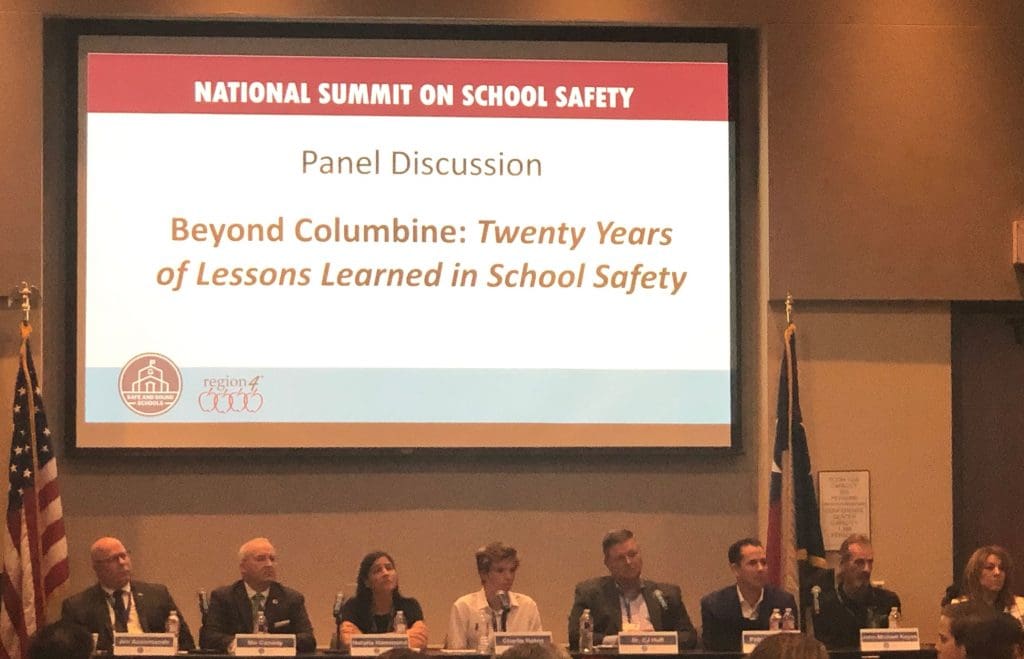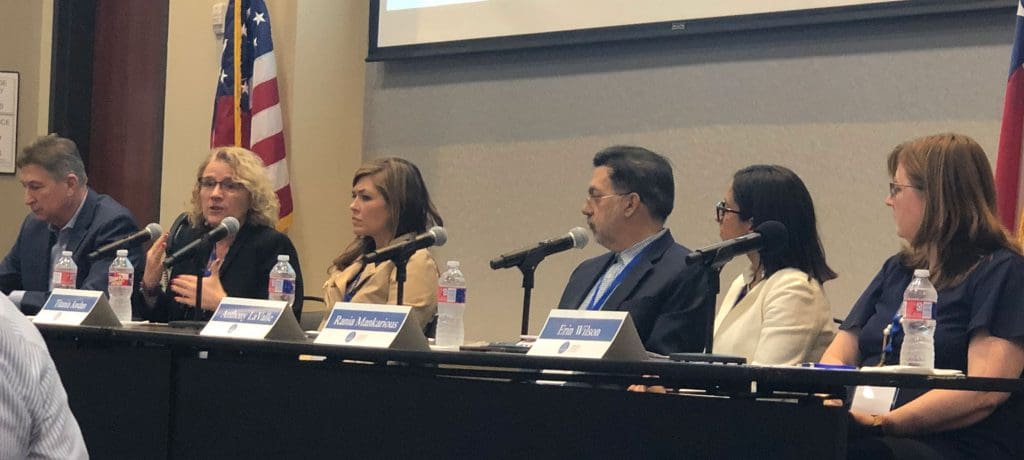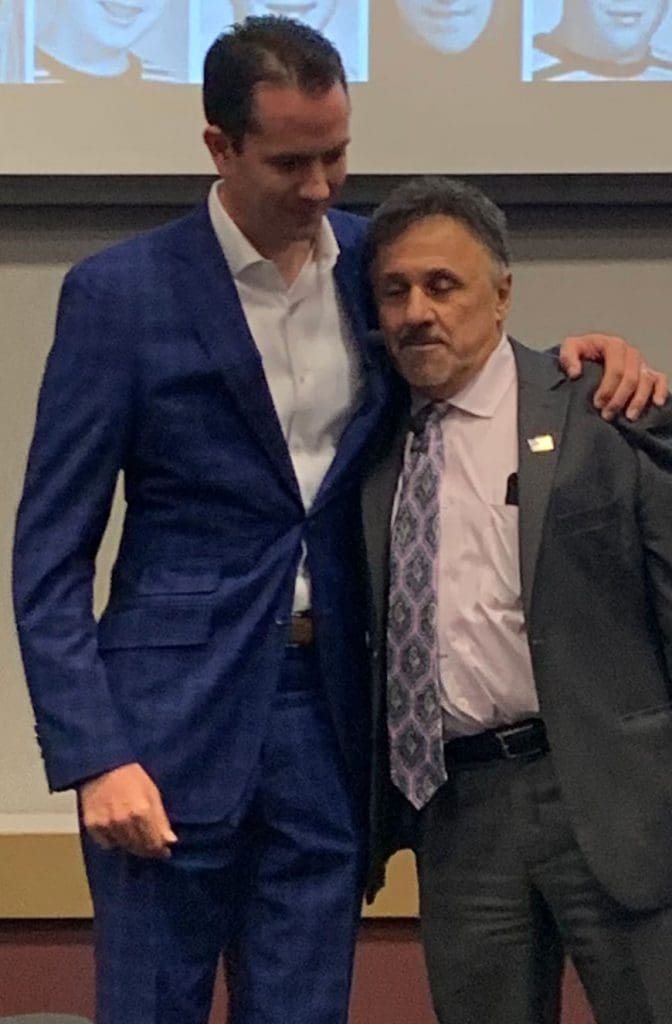Mental health. Gun restrictions. Access control. Video surveillance. Threat assessments. Emergency drills. School resource officers. Social media monitoring.
The above are examples of ways schools have invested in improving school safety. While their order of importance or overall effectiveness could be endlessly debated, there seemed to be one recurring sentiment throughout last month’s National Summit on School Safety: the importance of developing meaningful relationships between all school community stakeholders.
Hundreds of school safety professionals — including educators, administrators, behavioral health professionals, solution providers and community leaders — came together at the inaugural event, hosted by Safe and Sound Schools in Houston, to share their personal experiences and exchange ideas on school safety best practices.
Michele Gay and Alissa Parker, co-founders of Safe and Sound Schools and the mothers of Josephine Gay and Emilie Parker, who both lost their lives at Sandy Hook Elementary, opened the event, walking attendees through their perspectives of December 14, 2012.
The dynamic duo discussed how they made it from the moment they found out their daughters’ lives were senselessly cut short to now being able to speak to others about their experiences in the hopes of preventing other families from going through what they are.
For Michele, it was her three pillars of support that got her to this point: faith, friends and family. Through therapy and connecting with others, Michele found the strength to carry on her daughter’s memory while helping others.
“I want you to check your pillars because you may be faced with a difficult day like we were,” she urged a captive audience, emphasizing the importance of having a strong support system. “You are a pillar yourself for your friends, family and colleagues.”
Alissa recalled asking herself the question, ‘How do we send our two other children back to school?’ Her question was quickly answered when, not long after the tragedy, her two daughters asked, ‘When can we go back?’
Both Alissa’s and Michele’s children wanted to return to school, even after something so terrible happened, because so many of the people they had developed meaningful relationships with over the years were within those walls.
Columbine, Sandy Hook Survivors Discuss Their Recovery
On Day 2 of the event, a panel consisting of an association president, an association executive director, a former superintendent, and school shooting survivors, to name a few, discussed their unique viewpoints on school safety and how they are working tirelessly to ensure all students feel safe every day they walk into school.

National Summit on School Safety panelists, from left to right: Jim Accomando, president of the National Parent Teacher Association; Mo Canady, executive director of the National Association of School Resource Officers; Natalie Hammond, surviving Sandy Hook teacher; Charlie Hobin, student leader and founder of Orange United; Dr. CJ Huff, former superintendent of the Joplin, Missouri schools; Patrick Ireland, surviving Columbine student; John-Michael Keyes, father of Emily Keyes and executive director of the I Love U Guys Foundation; and Dr. Melissa Reeves, past president of the National Association of School Psychologists.
Patrick Ireland, surviving Columbine student, and Natalie Hammond, surviving Sandy Hook teacher, both spoke to how family and community support has helped them in their ongoing recovery.
Patrick encouraged open communication with family, teachers and school counselors. He said in some ways, he felt “chosen” because his family was in a good position to handle what had happened.
Natalie brought the discussion back to pillars of support, describing how doctors moved her to the end of the hallway near the waiting room because she had countless family members coming to visit as she recovered from her gunshot wounds.
Not everyone is as plentiful in family support as Patrick and Natalie, but if you are, don’t underestimate the importance of those closest to you when you are faced with a traumatic event.
NASRO Executive Director, Former Superintendent Discuss Their Perspectives
Mo Canady, executive director of the National Association of School Resource Officers (NASRO), also spoke on the panel. Canady said the main purpose of a school resource officer is to bridge the gap between law enforcement and youth.
“Sometimes I get questions from anti-law enforcement groups who want more counselors and mental health specialists. So do I,” he agreed. “They’re our best friends. A good SRO is going to build relationships with school counselors and mental health specialists. We’ve got to work together. There’s got to be a team approach when dealing with [school safety].”
While many might see SROs as only there to keep out the ‘bad guys,’ their real purpose is to make students feel comfortable approaching them or any other law enforcement officer with questions or concerns, both inside and outside of school. It’s just an added bonus that they have professional protection training.
Later in the afternoon, another panel featuring national experts in safety technology and practitioners from the field discussed available tools and technology for safer schools.
Dr. Catherine Finger, a former superintendent, summed up school safety in three words: relationships, culture and community.
When her district was building a new high school, many concerned parents wanted to implement safety measures while also making sure they wouldn’t lose “the love” they felt in the schools. They wanted to ensure their children did not feel like they were walking into a prison.
“As a high school superintendent, my goal was for every single one of my students [and] families to walk into their home. Our school was their home,” she said. “What does protection look like, feel like, act like within a home? What would a sense of peace, safety and home look like in a school?”
With that question in mind, she created a community forum consisting of students, parents, police and fire, among others.
“Bring them in. Learn from them as everyone has a different perspective on school safety and bridge relationships with all community stakeholders,” she concluded.

National Summit on School Safety panelists, from left to right: Bruce Canal, director of industry associations, Axis Communications; Dr. Catherine Finger, business development manager, NaviGate Prepared; Titania Jordan, chief parent officer, Bark Technologies; Anthony LaValle, founder, ReportIt; Rania Mankarious, chief executive officer, Crimestoppers of Houston; and Erin Wilson, Door Security & Safety Foundation ambassador.
28-Year Law Enforcement Veteran: We Must Teach Empathy
At the summit, I had the opportunity to speak with Safe2Tell founder Susan Payne — who has also been a D.A.R.E. officer and an SRO in her 28-year law enforcement career — about the importance of creating an open dialogue between students and staff.
“I learned that bridging relationships with young people was critical to the success of any school,” she said. “I remember being a D.A.R.E. officer and they said, ‘You can’t come in too nice.’ You get a lot of different training in your career, but I think there is certainly more of an effort [to] build relationships with our students, and when we can know that they are safe in school and happy and healthy, then it is about that, as well as academic achievement. Those that are in that space of feeling safe are going to achieve at a higher level. It goes hand in hand.”
Susan also touched on the importance of ensuring students have open communication amongst each other. She referenced a viral YouTube video where a Texas teacher assigns a student greeter each day to say, ‘Good morning’ and to offer a hug, a high-five or a simple handshake to each of their peers as they enter the classroom. The teacher said she does it to teach good manners and to show that “someone is on their side.”
“That’s what we want to see adults doing. We want them in the hallways, saying, ‘Hey, glad you’re in school, hope it’s going good,'” Susan said. “It doesn’t matter if you’re coming to the classroom as an A-student, a D-student, or you have officers there for safety. We want to engage them in building that culture. But we need to do that with children. Giving them the skills to interact with one another, communicate with one another, ask what’s going on in their life, show empathy.”
During the tools and technology panel discussion, an attendee asked, “If I have only $1 for school safety, what do I spend it on?”
Susan has one recommendation.
“In a staff meeting, have a list of all students and have staff put a dot next to every student you have a relationship with. If there are any names that don’t have a dot next to them, then you need to work on that over the next month and be able to put a dot on that name. It’s an interpersonal relationship skill and it’s just a little way to be observant as an educator, a teacher, a counselor. It doesn’t matter if you’re a custodian, a cafeteria worker or a bus driver. Everyone can be involved in engaging in the student population and making young people feel connected to adults.”
Columbine Principal Says Student Relationships Are What Kept Him Going

Patrick Ireland and Frank DeAngelis after their closing keynote at the National Summit on School Safety.
Former Columbine principal Frank DeAngelis closed out the summit alongside Patrick Ireland (who, fun fact, is now his financial advisor) in a powerful keynote. DeAngelis discussed the tragedy from his perspective and said what has helped him most in his recovery are the relationships he has created with his students.
“What broke my heart as an educator was when people were counting the number of days they had until they retired. And what I’m thinking in my mind is, ‘You know who suffers is the kids.’ I would be willing to bet that I could walk into any school here in Houston or in the larger Texas area, and within five minutes, I can tell which teachers enjoy what they are doing. It’s because of the relationships they have with kids. And those teachers, they don’t need attendance policies or tardy policies because those kids want to be in their class,” he said. “When people would ask me, ‘Are you counting the days?’ I really was, because I only have 15 more days with my kids. Then 10 more days with my kids. Then five more days.”
Whether it be through prevention, intervention, or recovery work, meaningful relationships are what drives a community. We can’t stop all bad things from happening. But for those of us involved in school safety, ensuring all community members feel they have a spot at the dining room table and access to necessary resources will make a meaningful difference.













